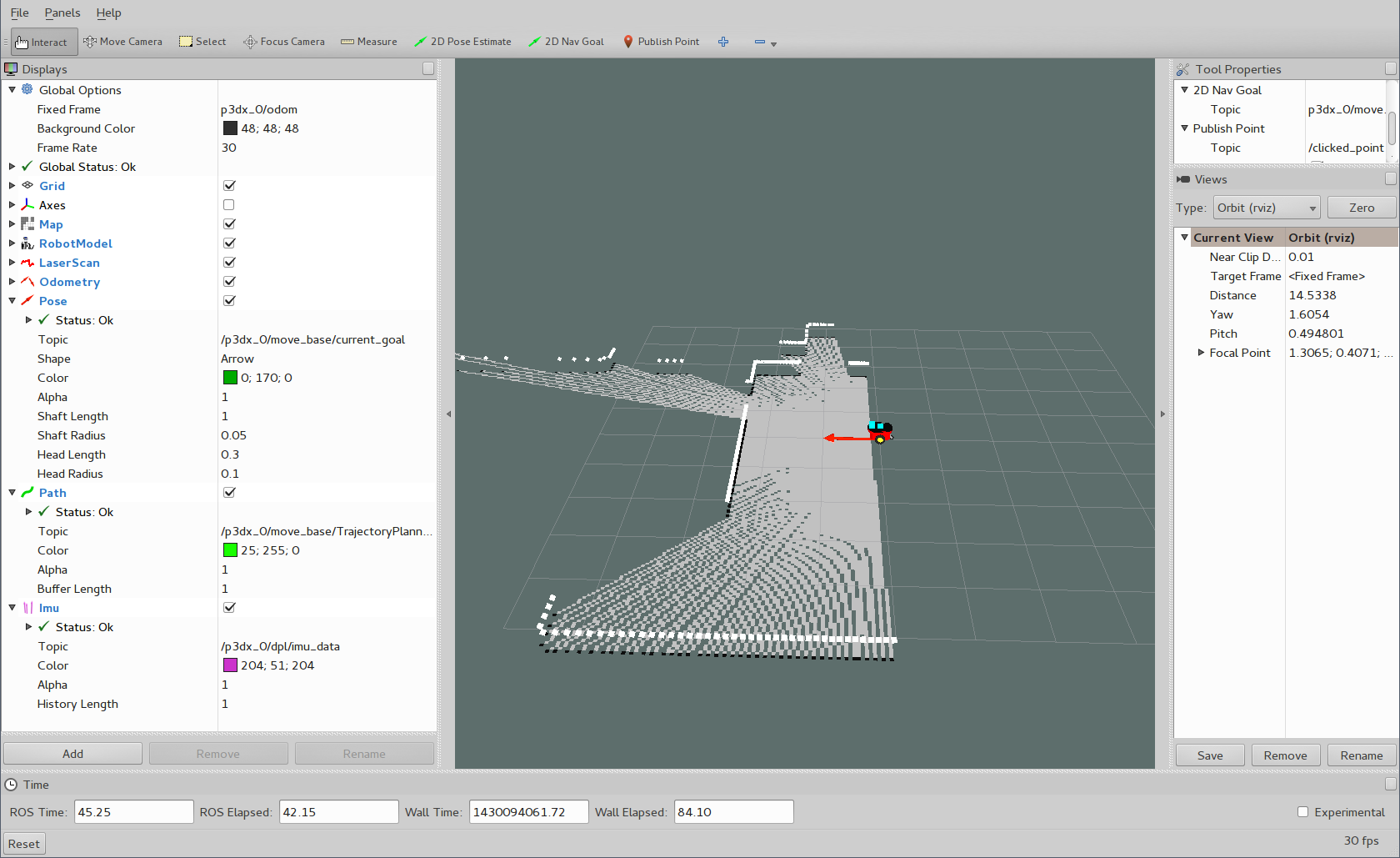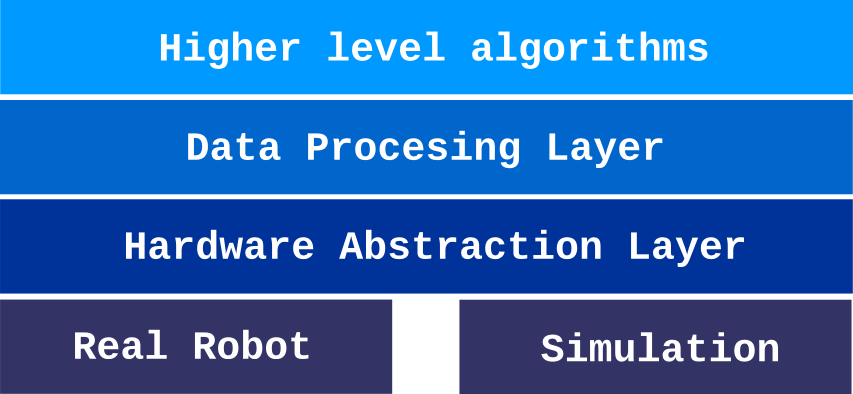Repository Summary
| Description | ROS nodes for rescue robots |
| Checkout URI | https://github.com/hrnr/robo-rescue.git |
| VCS Type | git |
| VCS Version | master |
| Last Updated | 2016-03-11 |
| Dev Status | UNMAINTAINED |
| CI status | No Continuous Integration |
| Released | UNRELEASED |
| Tags | No category tags. |
| Contributing |
Help Wanted (0)
Good First Issues (0) Pull Requests to Review (0) |
Packages
| Name | Version |
|---|---|
| p3dx_dpl | 0.0.0 |
| p3dx_hal_vrep | 0.0.0 |
| p3dx_robot | 0.0.0 |
| p3dx_urdf_model | 0.0.0 |
README
robo-rescue
ROS nodes for rescue robots
This project brings P3DX robot to ROS. It contains nodes for ROS which integrates with VREP robotic simulator. But its modular design allows easy porting to other simulators and even to real robots.
Although whole stack has been designed around VREP, it was designed with real robots in mind, and should allow easy porting of algorithms to real robots.
Building
This project contains standard ROS catkin packages, which is default build system in recent ROS releases. So to to build you need to install and configure your ROS environment first.
This steps expects your ROS environment and VREP simulator are installed and configured properly.
Also if you want to use VREP bridge, you need robo-rescue-simulation- vrep (this guide includes steps to install it too).
- clone this repository
git clone http://github.com/hrnr/robo-rescue
- link (or copy) VREP common bridge to your workspace (this is needed to communicate with vrep)
ln -s <VREP dir>/programming/ros_packages/vrep_common <catkin workspace>/src/vrep_common
- add project packages to your workspace
cp -r robo-rescue/src/* <catkin workspace>/src
- build your catkin workspace
cd <catkin workspace>
catkin_make
You may also need to install other ROS packages such as gmapping and
move_base. This dependencies can be installed by
rosdep.
Running p3dx_robot
If you have retrieved and built all packages successfully you can run robot with these steps.
- clone repository containing VREP model and test enviroment
git clone https://github.com/hrnr/robo-rescue-simulation-vrep
- run
roscore(this must be running before VREP)
roscore
- load scene and robot model in vrep
File > open scene ... robo-rescue-simulation-vrep/test_scenes/level01.ttt
File > load model ... robo-rescue-simulation-vrep/models/pioneer-p3dx.ttm
-
run simulation in VREP (PLAY button)
-
run P3DX via roslaunch
roslaunch p3dx_robot p3dx.launch
That’s it, your P3DX robot is running in ROS
You can check that everything is running with rostopic list robot topics
starts with /p3dx_0 since this is first PD3X in simulation. Check some topic
with rostopic echo, it should publish messages.
Run rviz for little demo. Load rviz config file from src/pioneer-
p3dx/p3dx_robot/config/p3dx-config.rviz. Set 2D Nav Goal to robot, it will
go to specified location and map its environment. This is how robot looks in
its initial pose:

Architecture

This project uses layered architecture to create multiple layers of abstraction. Bottom layer is Hardware Abstraction Layer. With aim to hide maximum of hardware differences. Middle layer (DPL) aggregates multiple data streams from HAL into single data stream. Top layer holds higher algorithms which operate on the whole robot. Thanks to clearly defined layers is this architecture suitable for fast prototyping of robots.
Hardware Abstraction Layer

Interface robot <-> HAL
HAL receives raw data from sensors and sends raw low level commands to joints. Data may come from real robots as well as simulation. Nodes of HAL should transform data ,which come from variety of bus interfaces and sensor or actuator types. This layer is therefore uniquely build for each robot depending on its configuration. This layer also holds function of synchronizer. In case of simulation it should set ROS default time to simulated. Otherwise it should time-stamp data with ROS default system time.
Interface HAL <-> DPL
Messages send as an output from HAL must be time_stamped for use in future calculations. Every message should have set proper ID connecting submitted data with location of sensor on robots body (frame_id). Every time of sensor has predefined type of message which may publish.
- Ultrasonic ,IR ,Bumpers : sensor_msgs/Range
- Laser scanners : sensor_msgs/LaserScan
- Joints ,Motors : sensor_msgs/JointState
- Accelerometers, Gyroscopes, Magnetometers : geometry_msgs/Vector3Stamped
Our HAL implements abstraction for PioneerP3dx robot simulated in V-rep.
## Data Processing Layer
 ### Overview
DPL aggregates multiple data streams received from HAL. These messages must be fused together to provide overall robot state information. All data should be transformed to robot main frame_ID called base_link and then processed. Output from this stack of ROS packages should be come standardized ROS messages like Odom, PointCloud ,LaserScan. These messages are commonly used in algorithms. This layer also includes passing messages from algorithms to bottom layers. These are mostly represented by Twist commands for movement of the robot. Twist message is translated into angular velocities of robot motors.
### Overview
DPL aggregates multiple data streams received from HAL. These messages must be fused together to provide overall robot state information. All data should be transformed to robot main frame_ID called base_link and then processed. Output from this stack of ROS packages should be come standardized ROS messages like Odom, PointCloud ,LaserScan. These messages are commonly used in algorithms. This layer also includes passing messages from algorithms to bottom layers. These are mostly represented by Twist commands for movement of the robot. Twist message is translated into angular velocities of robot motors.
## Algorithms This layer includes all algorithms needed for successful navigation of robot. It includes SLAM algorithm for map building and localization. It also needs to avoid obstacles and plan robot motion. Lastly This layer will include basic robot AI.
## TF Tree This project use standard ROS TF tree. It is formation of coordinate frames of all vital parts of the robot. Robot model is described in URDF file. TF uses forward and inverse transformation in between the frames. The main structure of the robot consists of frames: map -> odom -> base_footprint -> base_link ->[robot structure ,sensors and actuators].
Namespaces
Whole project use same hierarchical approach in naming. All names in [] are dynamically substituted. Topics:
- [robot_id]/topic_name : Algorithms namespace
- [robot_id]/dpl/topic_name : DPL namespace
- [robot_id]/dpl/hal/[node_name]/sensor[ID]/data type :HAL namespace
# API Documentation
